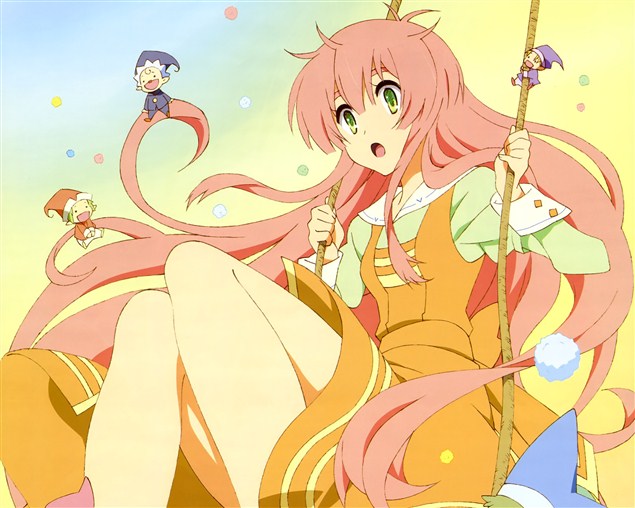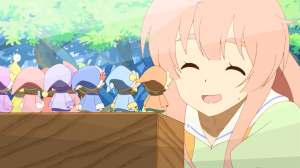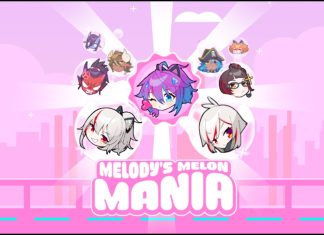As I wrote in my earlier article on Jinrui wa Suitaishimashita (now to be referred to as Jinrui), “I could write much more on this show, and I probably will when it finishes airing”. Little did I know then what I was getting myself into, as this won’t be easy.
To be frank, I initially believed I had the show figured out. It was a juicy parody of modern anime and manga, coupled nicely with a critique of contemporary culture and topped off with some delicious self referencing humor. Then the three final episodes came, and my satirical parody began to pose some difficult universal moral questions, and hell, it even answered some.

While episode 11 was the sonnet-like turn for the series, episodes 09 and 10, “The Fairy’s Survival Skills” and “The Fairy’s Earth”, were the real beginning of the end. While they fit the theme of the previous episodes completely and at the time just felt like totally normal episodes, they began to develop the themes that would come later, and posed the first question, “what makes human culture?”.
Now, it is quite clear that the faeries themselves are meant to represent a sort of naive new human population; an even greedier metaphorical view might say they represent youth culture. That is to say, they are eager to develop their own culture, but will gladly copy anything and everything. However, due to the impermanence of their physical selves and their works, it is clear they are not always satisfied with what they create, nor will they ever be. As illustrated in “The Fairy’s Survival Skills”, all civilizations fall, and all cultures eventually burn away. Human culture is defined by the failures of civilization, more precisely, what universal truths are able to survive the pillaging of temples and the burning of cities.
Therefore, the faeries are not human yet. The show itself juxtaposes faeries as the “new” humanity and the humans as the “old”. And, unlike the “old” humanity in Jinrui, the faeries have no need for the remembrance of dead cultures and failed experiments. When the faeries succeed, they move on. When they fail, they move on too. They can never truly advance because they cannot remember. There is no universal truth for them, save their love of sweets. This is what makes them reliant on our heroine, literally, for treats, but figuratively for a sense of remembrance and a continuity. Fairy culture is distinctly non-human, but we can still learn from it.
What can we learn? Namely that the reason fairy culture so miserably fails every single time is due to a lack of continuity and a immature unwillingness to learn from mistakes. Thus, human culture succeeds because it builds upon itself. This is what Jinrui will focus on in the next few episodes, and this is what we will get to. What we have now learned forms the basis of the second question, “what makes us human?”, or, more concretely within the show, “what separates humans from faeries?”.

Now we get into episodes 11 and 12, which feature a distinct lack of faeries. While they are not completely absent, they are no longer the focal point of the story. Human beings are. “The Fairy’s Secret Tea Party” parts 1 and 2 portray humans as selfish, secretive, violent, petty, and above all, cruel. All of these apparent faults are missing in fairy culture. One could then make the claim that fairy culture fails because it is not individualistic nor competitive. Humans possess a psychopathic side that allows them to flourish, while faeries are distinctly lacking of this. Faeries can more easily work together than humans can, but they cannot create anything permanent. They simply lack any sense of ownership and any sense of preciousness that comes with an individualistic society.
Jinrui thus presents humans not as the “social” animal, but as the “solitary” animal. While the earlier episodes have been commonly regarded as anti-consumer culture and assuredly anti-capitalism, this is simply not true. Jinrui is most certainly not pro these things, though.
While Jinrui does present the power of humanity to be individuality, “The Fairy’s Secret Tea Party” parts 1 and 2 demonstrates the need for humans to find peace between one another. The heroine herself finds strength in this idea of collective individuality. Everyone has extreme faults, but if one can look past these gaping holes of character, one can find peace with oneself and others, and our heroine discovers this through her time with the Wildrose Society.
This is closely linked with maturity. As our heroine grows up in her school, she becomes more and more social, but increasingly paranoid and hidden behind her veil of apathy. She learns that she can coexist with others, though this does not mean she needs to trust them. Her forced ignorance lets her become friends with the other, rather detestable members of the Wildrose Society, and she becomes much happier.
What makes humans different from faeries, then, is the ability to deceive, to fight, and ultimately, to make peace.
So if faeries are not human, what are they? This is the third question. “What exactly do the faeries function as within the Jinrui narrative?”. This may seem like the least important question, but I have saved it for last because it’s answer is the most profound.
Fairy culture is not objectively worse than human culture. While short lived, it is happy. While decadent, it is pure. While impermanent, it is noteworthy. As we touched on before, faeries may represent youth culture. They represent an immature humanity. While this parallel is possible, I don’t think it is everything.
Now, bear with me for this may seem a little too daring, but faeries represent the absolute worst of human culture. They are gluttonous, generally xenophobic, and completely over the top. They are the worst part of consumer culture, and they often do more harm than good. The factory they build almost causes the destruction of old humanity, the country they build on the island destroys the island, and all the while not a single entity is berating them. The faeries are like the youngest child of old humanity. The old humans let them do whatever they want, and are simply too tired and too hypnotized to do anything to stop them.
And yet, faeries also represent complete perfection. In their society, no one is lesser and no one is greater. No one is poor and no one is rich, and everyone seems happy enough. We have reached a paradox. Faeries are decidedly non-human, but combine the worst of human culture with the ultimate goals of human culture in a seemingly successful way. They help the heroine make friends, and it is revealed they bring good luck to old humans. Faeries cannot be entirely bad.
So again, what are they? The faeries represent the constant struggle in humanity between the culture of civilization and the infantile self. They represent the desire to be selfish and the desire to follow the golden rule. The desire to hate and the desire to love, but most of all, they represent pure, unadulterated kindness.
That sounds utterly contradictory, but it is true. When the faeries exploit our heroine for sweets in “The Fairies’ Time Management” parts 1 and 2, they have only self preservation in mind. Yet, they are kind about it. They do not wish harm onto the heroine, and they are kind enough to release her eventually. In the end of “The Fairy’s Secret Tea Party”, it is revealed a fairy is what kept the Wildrose society together. The faeries are not purely selfish, they too, can help others.
Just as the heroine grows up, the faeries too, can grow up. Jinrui posits that human culture still has a long way to go. It is altogether too cruel and judging, and while individualism and healthy competition is important to the preservation of a society, so is a love between peoples.
Humanity has declined, but hope emerges. I echo what was said earlier, the true mark of a culture is what survives after it’s death. Human society has failed in Jinrui, but in reality, it has just begun.
So we leave with that. Jinrui gives us a message of hope in trying times. From death comes rebirth, and from rebirth a greater life emerges. We have all failed at some point. One must not wallow in failure like “old” humanity”, nor forget it like “new” humanity. One must remember it and keep failure sacred, for imperfection, not perfection, makes one human.

“Give, and it shall be given to you. For whatever measure you deal out to others, it will be dealt to you in return.”










